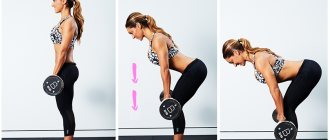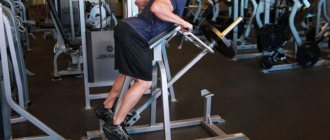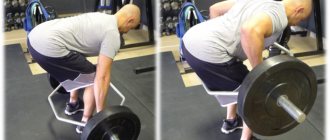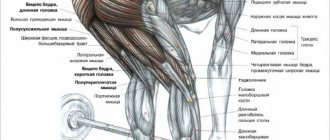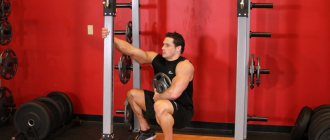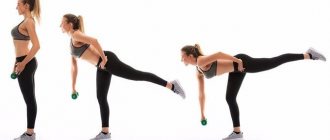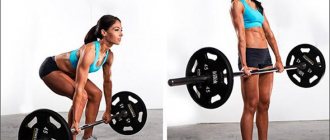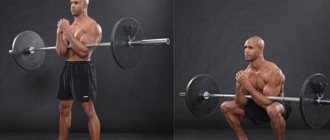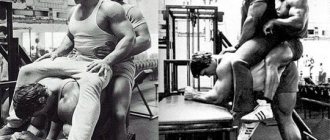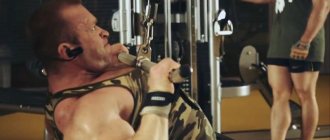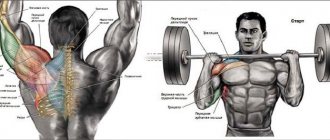Literally everyone who lifts weights in the gym or at home has heard about the benefits of the deadlift, considered a cult exercise. The effectiveness of the exercise is noticeable only if the execution technique is followed. This determines the need to know the basic (theoretical) principles of deadlift, the features and differences of its various types.
Many articles, which are presented in large numbers on the Internet, claim that deadlift is the main discipline, without which it is impossible to achieve results in pumping up certain muscles. How fair this is can be judged by a clear understanding of which muscle groups are involved in the exercise and how they work.
Deadlift is a multi-joint exercise involving lifting sports equipment such as dumbbells, barbells, and weights. It involves about seventy-five percent of the muscles, the load on which varies. Only the biceps femoris muscle, extensors (long muscles) of the back, and buttocks are actively affected. The load on the forearm, abs, biceps, triceps and quadriceps, latissimus and calf muscles is exclusively static.
Trap bar, trap bar
In this article, you can download drawings of a trap neck, and you will also learn how to make it yourself in artisanal conditions.
The trap bar is designed for performing deadlifts. As you may have guessed, it is not possible to buy this neck from us. The invention of the trap bar was due to the inconvenience of performing deadlifts with a regular bar - it is located in front of the body throughout the entire amplitude of movement, thereby, as it were, pulling the athlete forward, which requires maintaining balance in this position, putting additional stress on the back muscles.
This is why the trap bar was invented, when using it the hands were positioned exactly at the seams.
As you can see in the photo, it is difficult to get your knees into the frame of the trap bar without touching it. This is especially inconvenient when performing exercises with heavy weights. When squatting, you have to keep your knees too close to each other.
Exercises with trap bar
Below you can see how to perform the exercise with a trap bar. The movement is the same as a regular squat or deadlift. If you hold a regular bar with a simple overhand grip when deadlifting, when performing an exercise with a trap bar, the grip of each hand rotates 90 degrees outward.
Trap bar deadlift
A visual photo of performing an exercise with a hexagonal trap bar. It is noticeable that the distance from the knees to the front crossbar of the trap bar is quite large.
So for manufacturing we need a metal circle with a diameter of 24mm and a total length of approximately 3.5m. You can buy with a margin of 4-4.5 m. The entire structure will be made only from this metal circle. If you are making a trap bar for pancakes with an internal diameter of 50mm, then you will also need to additionally buy a metal circle of the same diameter for attaching the pancakes. Trap bar squats
3. After you have welded the top and bottom parts, you have a solid hexagon without handles and without a pipe for hanging pancakes. Let's start cooking this pipe. To do this, cut off the corner of the hexagon to which you need to weld the pipe. Then we put it next to it and boil it.
It is worth noting here that after cooking each corner, a metal seam will appear on it, which must immediately be ground off with a grinder. Otherwise, if it is not ground off, the metal structure will no longer lie level with the surface. And when cooking the next corner, the design will turn out with a slight zigzag from the horizontal surface. Next, we weld the handles inside the hexagon, the ends of which are also pre-cut at an oblique angle. We finally grind down the uneven seams on the outer and inner corners with a grinder and get a finished, even trap bar. All that remains is to hang the pancakes and you can do the exercises.
So, once you have painted the trap bar, you can hang weights to make a trap bar from it. As you can see, there is nothing complicated in the design of the trap bar. The neck is strong and reliable provided that the connecting seams are welded correctly and diligently. Ready trap rod
Author's advice: despite the growing interest and popularity of such a type of barbell as the trap bar, its effectiveness is nevertheless, not surprisingly, at a very low level. In addition, in professional sports, athletes treat the use of a trap bar with disdain and they work with a regular straight bar, both in training and in competitions. The same applies to amateur sports. The fact is that everything that is best and most convenient has long been invented, and there is no need to reinvent the wheel or the wheel. Also, do not forget that the simpler the better, this also applies to the design of exercise equipment, in particular, barbells. Therefore, the author recommends, in an effort to build muscle mass, not to concentrate on various kinds of inventions, but to focus on ordinary folk methods, and get used to performing deadlifts with a straight bar, while simply gradually increasing the weight a little by 1-0.5 kg. And a trap bar can be made for the sake of healthy interest, out of curiosity, why the author of this article decided to make a trap bar.
How do you know when you need to get tested?
A change in the content of sex hormone binding globulin is manifested by a number of symptoms that both men and women will probably quickly discover in themselves:
- Sexual disorders that men will probably feel first;
- Decreased vital activity, performance, fatigue from less significant physical activity;
- State of depression, bad mood for no reason, apathy, irritability;
- Concentration disorder, absent-mindedness;
- Periodic hot flashes;
- Fragility of bones (development of osteoporosis, osteopenia), which makes them more brittle;
- Resistance (immunity) to insulin in diabetic patients;
- Rapid weight loss or, conversely, rapid weight gain;
- Weakening of defenses (decrease in immunity);
- Oily seborrhea (dysfunction of the sebaceous glands), hair loss up to baldness, acne;
- Menstrual irregularities;
- Gynecomastia (enlargement of the mammary glands in men).
Meanwhile, the listed symptoms should force a person to seek medical help, and not act according to his own understanding. The analysis is prescribed by a doctor, usually an andrologist or reproductologist. Here the reader has the right to complain that such narrow specialists usually do not work in small localities. Such cases are provided for, so often a referral for research comes from an endocrinologist, gynecologist or urologist. People who are typically tested are:
- have problems conceiving;
- are nervous about impotence and indifference to sex;
- male pattern hair is found and menstrual irregularities are noted (women);
- approach the age of “male menopause.”
To the above, it only remains to add that the analysis for SHBG does not require special preparation; patients donate blood in the morning (peak hours are from 8 to 11 am). Otherwise, everything is as usual: don’t eat, don’t smoke, don’t work hard, don’t be nervous.
26mm Open Deadlift Bar
Basic exercises—barbell squats and deadlifts—gain an increase in muscle mass and increase leg strength. But due to the many nuances in the technique, the elements are difficult for beginner athletes to master. Beginners often do not have developed hip and back muscles, which also makes strength training difficult and increases the risk of injury.
To safely perform basic exercises (deadlifts, squats), a trap bar was developed. The projectile is a frame welded in the form of a rhombus or hexagon. There are stops for pancakes on both sides, and two parallel handles are located inside.
The trap bar does not require an additional stand or power racks. The apparatus lies on the floor, and the athlete simply steps inside the frame.
What kind of vulture is this?
A trap bar is a bar for deadlifting, an ergonomic sports equipment, which is a hexagon-shaped frame with handles running along the torso and stops for placing weighting discs. The athlete performs the movement while being inside the frame of the sports equipment, which ensures a more comfortable and safe performance of the exercise.
Deadlift with trap bar
The classic deadlift technique involves holding the bar in front of you. Accordingly, the grip of the palms is straight. In this position, the load created by the projectile shifts forward, which increases tension in the lumbar region. Therefore, beginners and people with weak backs are not recommended to perform this exercise.
In turn, the deadlift with a trap bar, thanks to its design, allows you to keep the weight coaxial with the body line, which reduces the dangerous impact on the muscles and ligaments of the back.
The second advantage of the trap bar is the creation of an unusual load. An athlete's muscles quickly adapt to monotonous exercises, even basic ones. Therefore, professional athletes recommend updating the training program every 4-6 months.
Using a trap bar allows you to change the usual angle of impact on the body, which “shocks” the muscle fibers and stimulates them to grow. The athlete gets the opportunity to perform basic strength elements, without the need to radically change the training plan and increase intensity.
Something about squats
Due to the closed design of the apparatus, the athlete can lower the body in only one position. This means that deadlifts and squats with a trap bar have the same technique. Therefore, the exercise is called differently.
It is worth noting that the advantage of a squat with a trap bar over the classic element with a barbell on the shoulders is the absence of a compressive load on the spine and comfortable holding of the apparatus. Thanks to this, athletes can safely increase weight and progress.
What muscles work
When performing deadlifts with a trap bar, the main load is taken on by the quadriceps and buttocks. The back extensors, rhomboids, scapular muscles, and trapezius stabilize the body. The abdominal muscles and forearms are indirectly worked out.
Execution technique
Most athletes who have used the trap bar have noted that the deadlift becomes easier with this apparatus. Due to their design and the way they were held, they could lift much heavier weights.
Let's look at the exercise technique:
- Place the weights on the supports and step inside the frame.
- Place your feet at shoulder level and turn your toes slightly outward.
- Sit down and firmly grasp the parallel handles.
- Stand up straight, holding the barbell with straight arms.
- Straighten your shoulders, raise your head.
- While inhaling slowly, simultaneously move your pelvis back and bend your legs.
- When the pancakes touch the floor, exhale and rise.
- At the top, straighten up completely and pause for a second before the next repetition.
The technique, as we see, is simple. Now let’s look at the small nuances and recommendations to make the exercise as productive and safe as possible:
- Deadlift is a basic element. Therefore, it should be performed at the beginning of strength training.
- Be sure to warm up. Warm up your muscles with light cardio (5-7 minutes) and weightless squats.
- Before strength sets, do 1-2 sets without weights to find a comfortable hand position.
- Pull the trap bar on the rubberized surface of the gym. This will help reduce the noise impact from the pancakes touching the floor.
- Wear weights. A flat, wide sole and a small heel will help keep your body balanced.
- Don't allow "beating". The sharp, shock braking of a projectile on the floor has a bad effect on the joints of the hands.
- Avoid bringing your knees inward. If this happens involuntarily, reduce the weight of the barbell.
- Make sure your lower back remains arched. Otherwise, the dangerous load on the lower back will increase.
- Don't sit too low. The pelvis should always remain slightly above the knee joints.
- Keep your gaze 45° to the ceiling. This will help keep your back arched and your shoulder blades retracted.
- Control all movements. It is unacceptable to “throw” the body down. The positive and negative phases should be uniform.
- Use supporting accessories: wrist straps, elastic knee wraps, weightlifting belt.
- To increase strength, perform 3-4 sets of 8-10 reps.
Contraindications
It is prohibited to pull a trap bar if you have the following diseases and conditions:
- pathology of bone tissue;
- intervertebral hernia;
- kyphotic and lordotic curvature of the spine;
- bruises, back sprains;
- damage to the meniscus of the knee joint;
- shoulder injuries;
- high blood pressure;
- recovery period after surgery.
In any case, if you have any diseases, we recommend that you consult a doctor.
Bent-over row with trap bar
Deadlifts and squats develop the legs, buttocks and lower back. But there is an exercise that allows you to train your upper body - bent-over trap bar rows. The element qualitatively loads the latissimus dorsi muscles, trapezius, scapular muscles, biceps of the arms, and rear deltas.
The exercise simulates training with a T-bar or bent over straight bar row. The main difference is the parallel position of the palms. This grip is comfortable and natural. Therefore, using a trap bar allows the athlete to focus on working the latissimus dorsi muscles, as well as lift more weight.
Let's look at the exercise technique:
- Stand in the frame, grab the handles, and straighten up.
- Place your feet narrower than your shoulders, approximately hip-width apart.
- Bend forward 40–45° and bend your lower back down as much as possible.
- Hold the projectile with straight arms.
- Pull your butt back slightly and bend your knees slightly.
- Exhale, pull the barbell to your chest.
- As you inhale, lower the bar to the starting position.
Now let's look at the nuances and recommendations:
- The bent over trap bar row is a basic exercise. Perform it at the beginning of a strength training session on the back.
- Before your main sets, do 1-2 warm-up sets without weights to warm up your arm joints.
- Don't spread your elbows wide, pull them close to your sides. This will allow maximum load on the latissimus muscles.
- At the top point, squeeze your shoulder blades together and tighten your back muscles. Stay in this position for 1-2 seconds.
- In the lower position, do not fully extend your elbows. Otherwise, the dangerous load on the joints will increase.
- Keep your head straight and look forward to maintain an arch in your back.
- Avoid "rounding" the spine. If this happens involuntarily, reduce the weight of the barbell.
- Perform the exercise evenly. Avoid jerking movements on yourself.
- To properly work out the back muscles, you should do 3-4 sets of 8-12 repetitions.
- To securely hold the projectile, use wrist straps.
The list of contraindications is similar to deadlifts and squats with a trap bar.
If you are a beginner athlete, most likely your muscles and ligaments are not yet ready for heavy basic elements. But without strength training, you won’t be able to build muscle mass. Therefore, we recommend including exercises using a trap bar in your training plan.
Benefits and Disadvantages of Trap Bar Deadlifts
Advantages:
- Thanks to the trap bar, the athlete changes the angles of movement during exercises, and accordingly, deep muscles are used to help the core muscles when performing the exercise. This leads not only to increased strength, but also to increased muscle size.
- Since the athlete’s position when performing exercises is more natural, as is the range of motion, the athlete is less susceptible to injury.
- Allows you to work with heavy weights.
- By increasing the load, the stimulation of anabolic processes increases exactly, as does the synthesis of anabolic hormones.
- The trap bar allows you to focus exercises on the target muscles, excluding the latissimus dorsi muscles.
The disadvantages of training with a trap bar are no greater than when working with other sports equipment that involves an axial load.
Benefits of exercise
Why a trap neck? Everything is very simple. Firstly, because the athletes’ bodies very quickly get used to the technique of simple exercises, be it, or. Therefore, the trap bar row allows you to shock the muscles. This, in turn, changes the angles of work, and, as a result, the involvement of deep muscles, which leads not only to an increase in functional strength, but also to a significant increase in terms of muscle fiber volume.
Secondly, unlike the previously mentioned exercises, the trap bar row is a more natural exercise for the body. And from this it follows:
- less traumatic;
- more natural range of motion;
- the ability to use more weight in loads.
In turn, this leads to an increase in load, stimulation of muscle fiber anabolism, and a decrease in catabolic processes, which makes the exercise irreplaceable.
And, perhaps, the most important thing is a change in the accent load. The trap bar row almost completely eliminates the latissimus dorsi muscles from the exercise. Instead, part of the load is absorbed by the small trapezius, which is especially important for athletes who do not train the upper back with isolation exercises.
Execution technique
If in a classic deadlift the athlete holds the bar in front of him with an overhand grip, and the load created by the apparatus is shifted forward, then when training with a trap bar, thanks to its design, the athlete keeps the weight in line with the body, which helps reduce the load on the ligaments and back muscles .
After the working weight has been established, the athlete must take the starting position:
- To do this you need to step into the bar frame. The feet should be placed at shoulder level, and the toes should be turned slightly outward. Then you should sit down and grab the handles located in parallel.
- The athlete must straighten up, standing on straight legs. Shoulders need to be straightened. Look straight ahead.
- The exercise is performed according to the same principle as with a regular barbell. The athlete inhales while moving his pelvis back and bends his legs, after which he exhales and lifts the weight.
- At the top point of the amplitude, you need to straighten up completely and stay in this position for a moment.
- Then slowly lower the barbell while inhaling and repeat the movement.
EZ-shaped neck
EZ-shaped neck
This apparatus is designed for people who have limited mobility in the hands or weak forearms. It allows you to target your biceps with exercises like the French bench press or barbell curl without putting unnecessary strain on your wrists and forearms.
Weight : 5–7 kg
Length : 1.2 m
Diameter : 28 mm
Recommendations for implementation in training
- The deadlift, as a basic exercise, should be performed at the beginning of your workout.
- Be sure to do a full warm-up, during which the ligaments and joints will be sufficiently warmed up.
- Also, before working sets, do several sets with an empty bar.
- If you have the opportunity to do weightlifting exercises, don’t miss it. These shoes will provide good balance.
- Do not lower the load with a kick. Hitting the floor has a negative impact on the joints of the hands.
- Don't lower your pelvis too low. Try not to let your pelvis fall below knee level.
- The negative phase and positive phase of the exercise should be the same in time.
- Pay attention to your knee joints! The knees should not fall inward.
- The lower back should have a natural arch.
Sets and reps
- To increase strength, perform 5-6 sets of 3-6 reps.
- To work on mass, a scheme of 3-4 approaches of 8-12 repetitions each is suitable.
- Women can perform deadlifts with an empty bar for 3 sets of 15-20 reps each.
Example of a strength workout using a trap bar
- Weighted pull-ups.
- Deadlift with trap bar.
- Belt row with trap bar.
For this workout, you should consider a strength training scheme in which the number of approaches needs to be increased and the number of repetitions reduced. For example, each exercise needs to be performed for 4-6 sets of 3 to 6 repetitions each. Be sure to include several warm-up approaches for each exercise in addition to working approaches. The number of repetitions in such approaches should be increased to 10-15 (moderate weight).
High, low result - both are unfavorable
The described laboratory indicator, which is constantly elevated for various reasons, can lead to the development of a pathological condition in other organs. For example, a high level of HSPC, promoting the proliferation of prostate tissue (prostate), increases the risk of developing not only a benign tumor, but also a malignant neoplasm (cancer) of this gland, which is important for the male body.
Due to the fact that the prostate is primarily at risk, even if it was previously healthy, it is worth noting the diseases in which elevated SHBG is recorded:
- Hyperthyroidism;
- Liver diseases (hepatitis);
- Infection with the human immunodeficiency virus (HIV).
An increased level of PG-binding globulin is observed in pregnant women, but this circumstance has nothing to do with pathology, since it is physiological in nature.
However, there are a number of conditions in which SHBG, on the contrary, is reduced. This can be observed when:
- Significant loss of protein through the excretory system (nephrotic syndrome);
- Connective tissue diseases (collagenosis);
- Neuroendocrine pathology (acromegaly, Cushing's disease);
- Hyperandrogenism in women (the production of androgens in the woman’s body changes or increases excessively);
- Stein-Levinthal syndrome or PCOS, or polycystic ovary syndrome (names of one pathology);
- Decreased functional capacity of the thyroid gland (hypothyroidism);
- Pituitary tumors (benign);
- NIDDM (type II diabetes mellitus).
A low digital indicator of the protein transporting PGs contributes to the formation of NIDDM (type II diabetes mellitus), which occurs due to impaired glucose metabolism in the liver. In such cases, the situation can be further aggravated by an unhealthy pancreas if the β-cells that belong to it and synthesize insulin begin to show functional failure. And in this case, it is no longer so important who owns the liver - diabetes usually does not choose gender.
